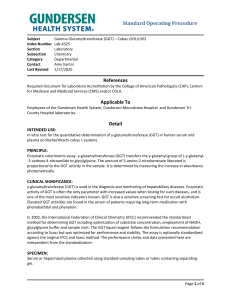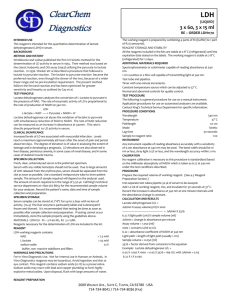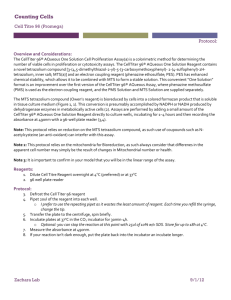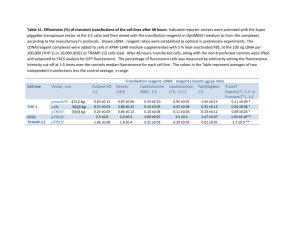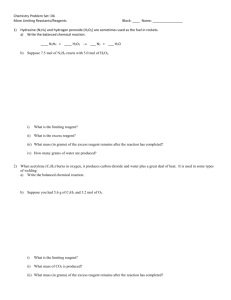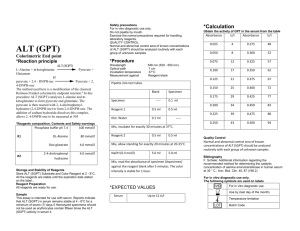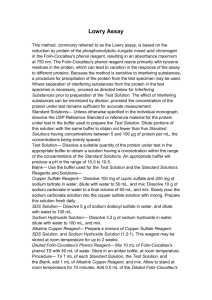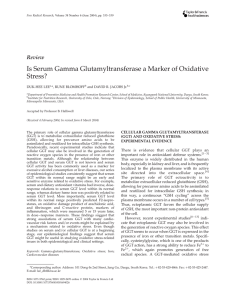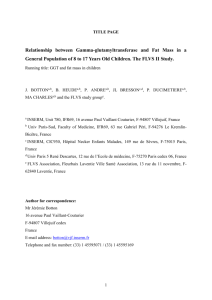3 x 60, 3 x 15 ml - ClearChem Diagnostics
advertisement
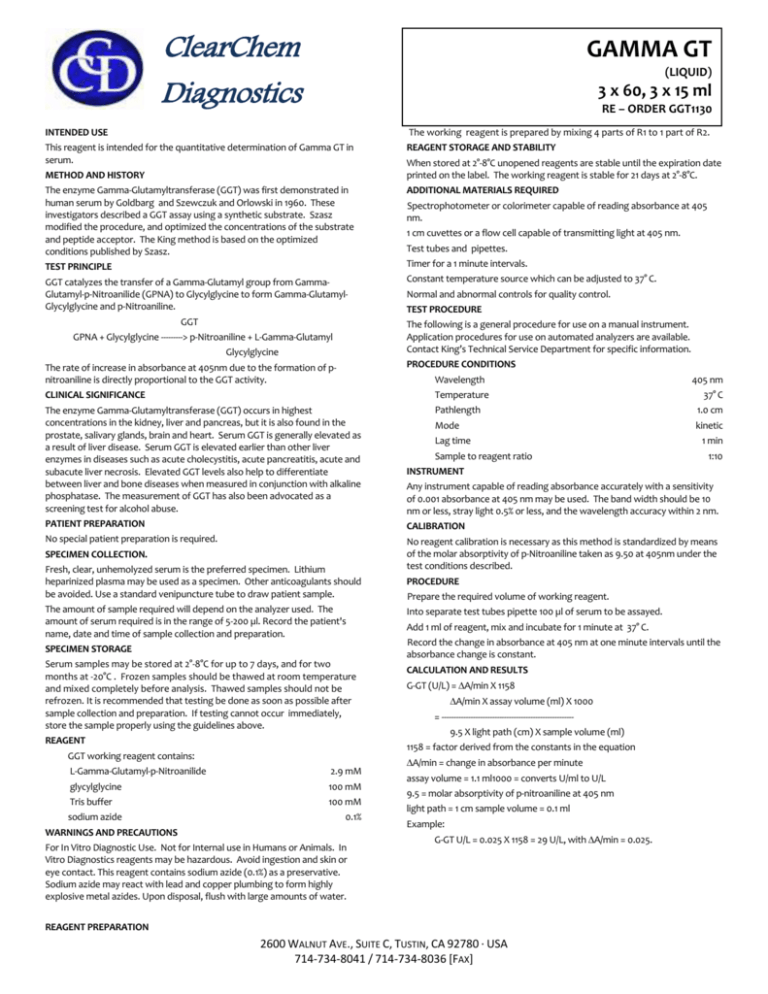
ClearChem Diagnostics GAMMA GT (LIQUID) 3 x 60, 3 x 15 ml RE – ORDER GGT1130 INTENDED USE The working reagent is prepared by mixing 4 parts of R1 to 1 part of R2. This reagent is intended for the quantitative determination of Gamma GT in serum. REAGENT STORAGE AND STABILITY METHOD AND HISTORY When stored at 2°-8°C unopened reagents are stable until the expiration date printed on the label. The working reagent is stable for 21 days at 2°-8°C. The enzyme Gamma-Glutamyltransferase (GGT) was first demonstrated in human serum by Goldbarg and Szewczuk and Orlowski in 1960. These investigators described a GGT assay using a synthetic substrate. Szasz modified the procedure, and optimized the concentrations of the substrate and peptide acceptor. The King method is based on the optimized conditions published by Szasz. ADDITIONAL MATERIALS REQUIRED TEST PRINCIPLE Timer for a 1 minute intervals. GGT catalyzes the transfer of a Gamma-Glutamyl group from GammaGlutamyl-p-Nitroanilide (GPNA) to Glycylglycine to form Gamma-GlutamylGlycylglycine and p-Nitroaniline. Constant temperature source which can be adjusted to 37° C. GGT Spectrophotometer or colorimeter capable of reading absorbance at 405 nm. 1 cm cuvettes or a flow cell capable of transmitting light at 405 nm. Test tubes and pipettes. Normal and abnormal controls for quality control. TEST PROCEDURE The following is a general procedure for use on a manual instrument. Application procedures for use on automated analyzers are available. Contact King’s Technical Service Department for specific information. GPNA + Glycylglycine ---------> p-Nitroaniline + L-Gamma-Glutamyl Glycylglycine PROCEDURE CONDITIONS The rate of increase in absorbance at 405nm due to the formation of pnitroaniline is directly proportional to the GGT activity. Wavelength 405 nm CLINICAL SIGNIFICANCE Temperature The enzyme Gamma-Glutamyltransferase (GGT) occurs in highest concentrations in the kidney, liver and pancreas, but it is also found in the prostate, salivary glands, brain and heart. Serum GGT is generally elevated as a result of liver disease. Serum GGT is elevated earlier than other liver enzymes in diseases such as acute cholecystitis, acute pancreatitis, acute and subacute liver necrosis. Elevated GGT levels also help to differentiate between liver and bone diseases when measured in conjunction with alkaline phosphatase. The measurement of GGT has also been advocated as a screening test for alcohol abuse. Pathlength 1.0 cm Mode kinetic Lag time Sample to reagent ratio 37° C 1 min 1:10 INSTRUMENT Any instrument capable of reading absorbance accurately with a sensitivity of 0.001 absorbance at 405 nm may be used. The band width should be 10 nm or less, stray light 0.5% or less, and the wavelength accuracy within 2 nm. PATIENT PREPARATION CALIBRATION No special patient preparation is required. No reagent calibration is necessary as this method is standardized by means of the molar absorptivity of p-Nitroaniline taken as 9.50 at 405nm under the test conditions described. SPECIMEN COLLECTION. Fresh, clear, unhemolyzed serum is the preferred specimen. Lithium heparinized plasma may be used as a specimen. Other anticoagulants should be avoided. Use a standard venipuncture tube to draw patient sample. The amount of sample required will depend on the analyzer used. The amount of serum required is in the range of 5-200 µl. Record the patient's name, date and time of sample collection and preparation. SPECIMEN STORAGE Serum samples may be stored at 2°-8°C for up to 7 days, and for two months at -20°C . Frozen samples should be thawed at room temperature and mixed completely before analysis. Thawed samples should not be refrozen. It is recommended that testing be done as soon as possible after sample collection and preparation. If testing cannot occur immediately, store the sample properly using the guidelines above. REAGENT Prepare the required volume of working reagent. Into separate test tubes pipette 100 µl of serum to be assayed. Add 1 ml of reagent, mix and incubate for 1 minute at 37° C. Record the change in absorbance at 405 nm at one minute intervals until the absorbance change is constant. CALCULATION AND RESULTS G-GT (U/L) = A/min X 1158 A/min X assay volume (ml) X 1000 = ------------------------------------------------------9.5 X light path (cm) X sample volume (ml) 1158 = factor derived from the constants in the equation GGT working reagent contains: L-Gamma-Glutamyl-p-Nitroanilide 2.9 mM glycylglycine 100 mM Tris buffer 100 mM sodium azide PROCEDURE 0.1% WARNINGS AND PRECAUTIONS For In Vitro Diagnostic Use. Not for Internal use in Humans or Animals. In Vitro Diagnostics reagents may be hazardous. Avoid ingestion and skin or eye contact. This reagent contains sodium azide (0.1%) as a preservative. Sodium azide may react with lead and copper plumbing to form highly explosive metal azides. Upon disposal, flush with large amounts of water. A/min = change in absorbance per minute assay volume = 1.1 ml1000 = converts U/ml to U/L 9.5 = molar absorptivity of p-nitroaniline at 405 nm light path = 1 cm sample volume = 0.1 ml Example: G-GT U/L = 0.025 X 1158 = 29 U/L, with A/min = 0.025. REAGENT PREPARATION 2600 WALNUT AVE., SUITE C, TUSTIN, CA 92780 · USA 714-734-8041 / 714-734-8036 [FAX] Page 2 EXPECTED VALUES Szasz, G., Clin Chem, 15,112(1969) Male: 8-37 U/L at 30°C, 9-54 U/L at 37°C Kaplan, L., Pesce, A., Clinical Chemistry Theory, C.V. Mosby, Princeton, NJ (1984) Female: 6-24 U/L at 30°C, 8-35 U/L at 37°C Due to a wide range of conditions (dietary, geographical, age, etc.) believed to affect normal ranges, it is strongly recommended that each laboratory determine its own reference range. MEDICAL ALERT VALUES Each laboratory should establish low and high values beyond which the patient would require immediate attention by a physician. If a "medical alert value" is reached, always repeat the test to confirm the result and notify a physician if the result is confirmed. LIMITATIONS OF PROCEDURE Oxalates, fluoride and citrate have been found to inhibit the reaction. Some antiepileptic drugs (phenytoin, barbiturates) may falsely elevate GGT values. Young gives a list of drugs and other substances that interfere with the determination of GGT activity. QUALITY CONTROL Standard practice for quality control should be applied to this system. Commercially available lyophilized controls can be used to monitor the daily acceptable variations. Normal and abnormal controls should be assayed at the beginning of each run of patient samples, whenever a new reagent or a different lot number is being used, and following any system maintenance. A satisfactory level of performance is achieved when the analyte values obtained are within the "acceptable range" established by the laboratory. CALIBRATION PROCEDURES No routine reagent calibration is necessary as this method is standardized by means of the molar absorptivity of p-Nitroaniline taken as 9.50 at 405nm under the test conditions described. The results obtained when measuring the activity of a kinetic reaction are based on the change in absorbance per minute. In order to accurately monitor and report this reaction rate, the operating parameters of the spectrophotometer (wavelength, temperature of the reaction and timing of the test) must be known and controlled. PERFORMANCE CHARACTERISTICS PRECISION The estimates of precision shown below were obtained from assays of human control serum. Within-Run Mean (U/L) SD (U/L) CV (%) 20.1 0.97 4.8 70.1 2.85 4.1 Mean (U/L) SD (U/L) CV (%) 23.1 2.68 11.7 73.0 4.29 5.9 Between-Run CORRELATION A correlation study was done comparing this method (y) with a similar comparative method (x). The samples ranged between 7 U/L and 300 U/L. Number Regression Equation Correlation of Samples y=King, x=Comparative Coefficient 102 y = 1.03 x – 1.24 0.999 LINEARITY This procedure is linear through 800 U/L. Procedures on automated instruments which use greater than one to ten (sample to reagent) dilution factor will have an extended linearity. A sample with Gamma GT beyond the linearity limit should be diluted 1 to 1 with 0.9% saline. Reassay the specimen and multiply the results by 2. SENSITIVITY A change in absorbance of 0.001 A/min at 405nm at 37° C corresponds to 1.1 U/L. REFERENCES Goldbarg, J.A., Friedman, O.M., Reveda, E.P., and Smith, E.E., Arch Biochem Biophys, 91,61(1960) Szewczuk, A., Orlowski, M., Clin Chem Acta, 5,680(1960) Young, D.S., Effects of Drugs on Clinical Laboratory Tests, 3rd ed., Washington DC, AACC Press (1990). G.J. Kost, "Critical Limits for Urgent Clinician Notification at U.S. Medical Centers"; JAMA, Feb. 2, 1990; Vol 263, No.5, p.704 Manufactured For: ClearChem Diagnostics
